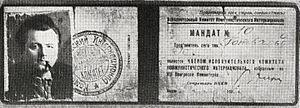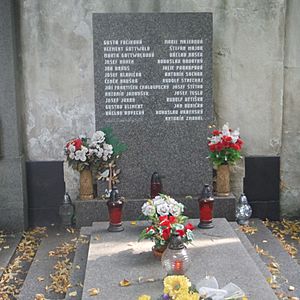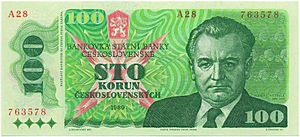Klement Gottwald facts for kids
Quick facts for kids
Klement Gottwald
|
|
|---|---|

Klement Gottwald in June 1948
|
|
| Chairman of the Communist Party of Czechoslovakia | |
| In office 1929 – 14 March 1953 (titled as General Secretary 1929–1945) |
|
| Preceded by | Bohumil Jílek as General Secretary |
| Succeeded by | Antonín Novotný as First Secretary |
| President of Czechoslovakia | |
| In office 14 June 1948 – 14 March 1953 |
|
| Preceded by | Edvard Beneš |
| Succeeded by | Antonín Zápotocký |
| Prime Minister of Czechoslovakia | |
| In office 2 July 1946 – 15 June 1948 |
|
| Preceded by | Zdenek Fierlinger |
| Succeeded by | Antonín Zápotocký |
| Personal details | |
| Born | 23 November 1896 Vyškov District, Moravia, Austria-Hungary |
| Died | 14 March 1953 (aged 56) Prague, Czechoslovakia |
| Political party | KSČ |
| Spouse | Marta Gottwaldová |
| Profession | Cabinetmaker Newspaper editor |
| Signature |  |
Klement Gottwald (23 November 1896 – 14 March 1953) was an important Czech communist politician. He led the Communist Party of Czechoslovakia from 1929 until his death in 1953. He was also the first leader of Communist Czechoslovakia from 1948 to 1953.
Before becoming president, he was Czechoslovakia's Prime Minister from 1946 to 1948. In June 1948, he became the country's first communist president. This happened after his party took control of the government with help from the Soviet Union. He remained president until he died.
Contents
Early Life and Beginnings
Childhood and Family
Klement Gottwald was born on November 23, 1896. He was born in a small village in what was then Austria-Hungary. His mother was a poor farmer.
He learned to be a carpenter in Vienna before World War I. He also joined a youth group that supported social democracy.
Gottwald married Marta Gottwaldová. She also came from a poor family. Marta was a loyal partner to Klement, but she never joined the Communist Party. They had one daughter named Marta.
Serving in the Military
From 1915 to 1918, Gottwald was a soldier in the Austro-Hungarian Army. In the summer of 1918, he left the army. After the country of Czechoslovakia was formed, he served in the Czechoslovak Army for two years.
Rising in Politics
Sports and Journalism
After his military service, Gottwald worked as a cabinetmaker. He also became involved in sports organizations for workers. He helped unite these groups and gained influence in local areas.
In 1921, he moved to Banská Bystrica and became an editor for a communist magazine called "Hlas Ľudu" (Voice of the People). He also organized sports events there. Later, he worked as an editor in Žilina and Ostrava.
Joining the Communist Party
In 1926, Gottwald became a full-time leader in the Communist Party of Czechoslovakia. He also worked as an editor for communist newspapers. He helped the party leadership in Prague, supporting those who wanted closer ties with Moscow.
From 1928, he was a member of the Comintern. This was an international organization of communist parties led by the Soviet Union. He helped the party become more like the Soviet Communist Party.
In February 1929, Gottwald was chosen as the party's general secretary. This made him a very important leader.
Exile and Return
In November 1938, the Communist Party was banned in Czechoslovakia. Gottwald then moved to the Soviet Union. While there, he disagreed with some Soviet policies, like the Molotov-Ribbentrop pact.
When Nazi Germany attacked the Soviet Union in 1941, the Soviets saw a chance to help Gottwald. They wanted him to lead Czechoslovakia after the war. In 1943, Gottwald worked with the Czechoslovak government-in-exile in London. They agreed to work together against fascism and form the National Front. This helped the Communists gain power in Czechoslovakia after the war.
In 1945, Gottwald returned to Prague. He became the deputy prime minister and chairman of the National Front. In March 1946, his party won a large share of votes in the elections. He then became the Prime Minister.
Gottwald strongly supported removing ethnic Germans from Czechoslovakia. He used strong nationalistic words, saying it was time to "return the Czech lands to the Czech people."
The 1948 Communist Takeover
By 1947, the Communist Party's popularity was decreasing. This was especially true after the Soviets made Czechoslovakia refuse aid from the Marshall Plan. Many thought Gottwald would lose his position in the upcoming 1948 elections.
Joseph Stalin, the Soviet leader, told Gottwald to remove political opposition to communism in Czechoslovakia. Gottwald pretended to work within the system, saying he wanted the Communists to win a majority in the elections.
The situation became tense in February 1948. Most government ministers told the Communist interior minister to stop filling the police force with Communists. The minister ignored this, with Gottwald's support. In response, 12 non-Communist ministers resigned. They hoped this would force Gottwald to step down.
Gottwald refused to resign. Instead, he demanded a new government led by Communists. He threatened a general strike if his demands were not met. His Communist allies took over the offices of the non-Communist ministers.
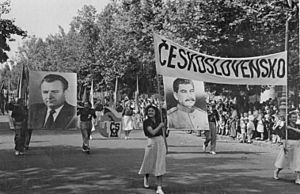
On February 25, the president, Edvard Beneš, gave in. He was worried about Soviet involvement. He accepted the resignations and appointed a new government chosen by Gottwald. This new government was mostly made up of Communists and their supporters. From this day on, Gottwald was the most powerful person in Czechoslovakia.
On May 9, the National Assembly, now controlled by the Communists, approved a new constitution. President Beneš refused to sign it. He resigned on June 2. On June 14, Gottwald was formally elected as President.
Leading Communist Czechoslovakia
As president, Gottwald made Czechoslovakia follow the Stalinist model of government, like the Soviet Union. He took control of the country's industries for the government. He also forced farms to become collective, meaning they were run by the state.
Some people within the government resisted Soviet influence. Gottwald responded by starting a series of "purges." This meant he removed people from power, first non-communists, then even some communists. Some were executed.
Important Communists who were victims of these purges included Rudolf Slánský, the party's general secretary, and Vladimir Clementis, the Foreign Minister. Slánský and Clementis were executed in December 1952. Hundreds of other government officials were sent to prison.
In a famous photograph from 1948, Clementis stands next to Gottwald. When Clementis was charged in 1950, he was removed from the photograph by the state propaganda department. This shows how the government tried to control history.
Death and Legacy
Klement Gottwald had heart problems. He died on March 14, 1953, at age 56. This was just five days after he attended Stalin's funeral. He was the first Czechoslovak president to die while in office.
Gottwald's body was preserved and put on display in a special tomb in Prague. However, in 1962, the idea of worshipping leaders like him ended. His body was then cremated, and his ashes were placed in a sarcophagus.
After the end of the communist era in 1990, Gottwald's ashes were moved. They were placed in a common grave at Prague's Olšany Cemetery with other communist leaders.
Places Named After Him
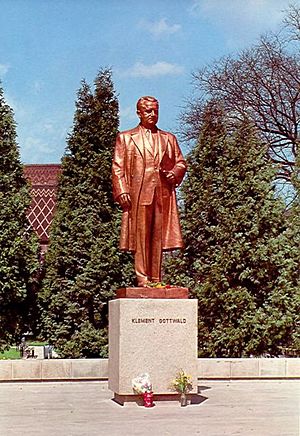
After Gottwald's death, Antonín Novotný became the new leader of the Communist Party. Antonín Zápotocký became president.
Many places were named after Klement Gottwald as a tribute. The city of Zlín in the Czech Republic was called Gottwaldov from 1949 to 1989. A city in Ukraine was also named Gotvald for a time.
A major square in Bratislava was called Gottwaldovo námestie. Today, it is called Námestie Slobody (Freedom Square). A bridge and a metro station in Prague were also named after him.
In 1989, a 100 Koruna banknote was issued with Gottwald's picture on it. However, people did not like this banknote. It was quickly removed from circulation in 1990.
In a 2005 poll on Czech Television, Klement Gottwald was voted "The Greatest Villain" in Czech history.
See also
 In Spanish: Klement Gottwald para niños
In Spanish: Klement Gottwald para niños
- History of Czechoslovakia
- Order of Klement Gottwald
- Photo manipulation
- Czechoslovak Communist party


